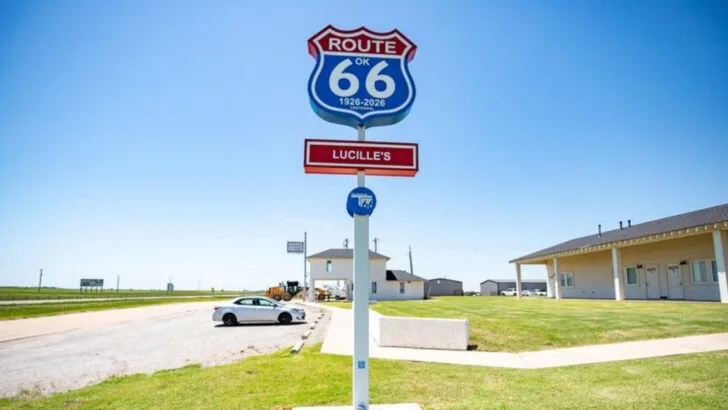There was a time when Route 66 was more than just a highway—it was America’s Main Street, connecting the Midwest to the West Coast in a ribbon of neon, diners, and dusty dreams. Along the way, hundreds of towns boomed with traffic, commerce, and cross-country travelers. But when the interstates came, many of those places were left behind.
Today, these once-thriving Route 66 towns are quiet, weathered, and in some cases, all but empty. The motels have faded, the gas stations sit silent, and the old road signs rust in the sun. And yet, for road trippers willing to detour a little, these ghostly spots offer a haunting look at the past—and maybe a place to grab a photo, or even a slice of pie.
Here are 12 nearly forgotten towns along Route 66 that remind us just how fast the world can change—and how much beauty there is in what’s been left behind.
Glenrio, Texas/New Mexico
Glenrio stands as a testament to the golden era of Route 66. Situated right on the Texas-New Mexico border, this town was once a bustling stop for travelers. In its heyday, Glenrio boasted service stations, cafes, and motels, all catering to weary road-trippers.
However, the construction of Interstate 40 bypassed Glenrio, leading to its gradual decline. Today, remnants of its lively past linger in the form of abandoned buildings and rusting signs.
Despite its desolate state, Glenrio’s unique position straddling two states makes it a fascinating stop for history enthusiasts exploring Route 66.
Texola, Oklahoma
Texola, Oklahoma, is a small town with a big history along Route 66. Once a lively frontier town, it offered services and amenities to travelers and locals alike. Its charm was evident in quaint shops and welcoming locals.
With the advent of the interstate, Texola found itself bypassed and fading into obscurity. Today, it’s almost forgotten, with a handful of residents keeping its memories alive.
Yet, Texola’s rustic charm and historical markers offer a look back at the days when Route 66 was a vital artery through America’s heartland.
Ludlow, California
Ludlow, California, rose to prominence as a mining town before Route 66 transformed it into a bustling pit stop. Travelers would flock to its diners and motels, seeking respite from the long journey.
As progress marched on, the town slowly faded, its buildings now standing silent against the desert backdrop. The echoes of its past are still visible in the dusty streets and abandoned structures.
Today, Ludlow serves as a reminder of the transient nature of success, a ghostly echo of the golden days of highway travel.
Erick, Oklahoma
Erick, Oklahoma, is known as the hometown of country music star Roger Miller. This charming town was once a vibrant stop along Route 66, bustling with activity and excitement.
The town’s decline began with the bypassing of the highway, leaving behind quaint shops and classic Americana. Yet, Erick’s spirit lives on through its quirky museums and nostalgic festivals.
Visitors today can explore Erick’s rich history, savoring the remnants of its musical heritage and enjoying the friendly atmosphere of this nearly forgotten gem.
Amboy, California
Amboy, California, was a popular stop along Route 66, known for Roy’s Motel and Café. This iconic spot drew travelers with its eye-catching neon sign and welcoming atmosphere.
However, Amboy’s fortunes shifted when the new interstate diverted traffic away, leaving the town a ghostly shell of its former self. Today, it stands as a symbol of the boom-and-bust cycle along Route 66.
Visitors to Amboy can still see Roy’s iconic sign, a beacon in the desert, reminding all of the town’s storied past and enduring allure.
Conway, Texas
Conway, Texas, is famous for its quirky leaning water tower, a roadside attraction that once drew countless travelers along Route 66. The town thrived on its unique charm and strategic location.
As highways evolved, Conway was left behind, its bustling streets now quiet and unhurried. The water tower remains, a whimsical reminder of the town’s vibrant past.
Though nearly forgotten, Conway’s distinctive landmark continues to attract curious visitors, eager to glimpse a piece of Route 66 history and the creativity that defined an era.
Bagdad, Arizona
Bagdad, Arizona, once thrived as a mining hub before Route 66 brought new life to its dusty roads. Travelers would stop for fuel and supplies, enjoying the town’s rugged charm.
In the shadow of progress, Bagdad faded as traffic dwindled and businesses closed. The quiet streets now tell tales of its industrious past and vibrant community.
Though largely forgotten, Bagdad offers explorers a chance to experience the stark beauty of the desert landscape and the haunting history of a once-bustling town.
Hydro, Oklahoma
Hydro, Oklahoma, gained fame through Lucille’s Service Station, a beloved landmark along Route 66. Known as the “Mother of the Mother Road,” Lucille Hammons provided hospitality to countless travelers.
As the interstate system expanded, Hydro’s prominence waned, leaving behind nostalgic memories of its golden days. Lucille’s Station remains a testament to the hospitality and warmth that defined the town.
Today, visitors can explore Hydro, discovering its rich history and the enduring legacy of Lucille’s welcoming spirit along the historic highway.
Newkirk, New Mexico
Newkirk, New Mexico, was once a bustling rest stop for Route 66 travelers, offering a taste of Southwestern culture and hospitality. Its inviting atmosphere charmed visitors from near and far.
Over time, the shifting routes of highways led to Newkirk’s decline, leaving behind a quiet town with echoes of its vibrant past. The adobe buildings still stand, whispering stories of bygone days.
Newkirk remains a poignant reminder of the ever-changing landscape of travel and the towns that rise and fall along its path.
Cuervo, New Mexico
Cuervo, New Mexico, nestled along Route 66, was once a lively town with a mix of ranchers and travelers. Its strategic location made it a vital stop for many.
The town’s fortunes dwindled as modern highways bypassed it, leaving behind stone ruins and empty streets. Yet, Cuervo’s spirit endures, its rugged landscape captivating those who visit.
Explorers today can wander through Cuervo, reflecting on the resilience of a community once alive with the hum of life along America’s Mother Road.
Essex, California
Essex, California, was a vital oasis for Route 66 travelers, providing fuel and rest in the harsh Mojave Desert. Its welcoming ambiance offered respite to road-weary adventurers.
As progress took its toll, Essex’s bustling activity slowed, leaving behind a serene yet haunting landscape. The silent gas stations and weathered signs speak volumes of its past.
Despite its near-forgotten status, Essex remains a poignant marker of the challenges and triumphs faced by those journeying through the desert on Route 66.
Ghost Town Ruins of San Jon, New Mexico
San Jon, New Mexico, now stands in ruins, a ghostly echo of its once-vibrant past along Route 66. The town thrived on agriculture and tourism, drawing visitors with its charm.
The bypassing of the highway led to San Jon’s decline, with nature reclaiming its streets and buildings. The remnants of homes and businesses tell stories of its bustling history.
Today, explorers can wander through San Jon’s ruins, reflecting on the passage of time and the enduring spirit of towns that once thrived on America’s iconic highway.

